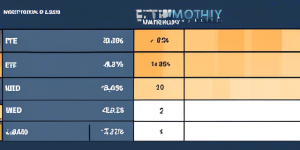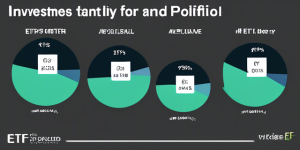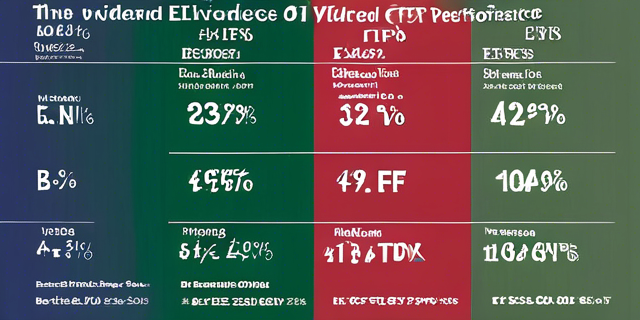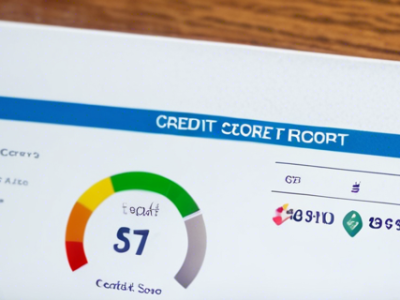Monthly Dividend ETF Portfolio Strategies

Constructing a portfolio of monthly dividend ETFs can provide investors with regular income and enhanced cash flow. By combining high-yield, monthly income ETFs spanning various asset classes, investors can implement an ETF portfolio strategy to produce consistent dividend payouts.
This comprehensive guide will explore the world of monthly dividend ETFs, the benefits they offer income investors, factors to consider when selecting specific ETFs, portfolio allocation approaches, and how to build a monthly income ETF portfolio tailored to one’s objectives.
Overview of Monthly Dividend ETFs
Exchange traded funds have become popular investment vehicles for easily accessing various market sectors and assets in a low-cost, diversified structure. Many ETFs track stock or bond indexes and provide the diversity of hundreds or thousands of individual holdings in a single ticker.
Monthly dividend ETFs simply are ETFs that are structured to pay out dividends on a monthly basis rather than quarterly. They are specifically designed for investors who want cash flow and income on a more frequent basis.
Some features of monthly dividend ETFs:
- Often hold high dividend-paying stocks and bonds.
- Typically have higher dividend yields than comparable quarterly dividend ETFs.
- Allow investors to compound returns more rapidly through monthly reinvestment.
- Provide steady, predictable cash flow at regular intervals.
- Wide selection across various asset classes like equities, bonds, REITs, MLPs.
Monthly dividend ETFs have grown in popularity among retirees and income investors who need more frequent cash distributions to help cover living expenses.
Benefits of Monthly Dividend ETFs

Monthly dividend ETFs provide several advantages compared to traditional ETFs and individual securities:
1. Steady, Reliable Income Stream
The regular monthly payouts provide investors a steady, predictable stream of income. This helps budgeting and cash flow planning compared to sporadic dividends from individual stocks.
2. Faster Compounding Through Reinvestment
More frequent dividends allow faster compounding when reinvested. Monthly compounding potentially boosts long term total returns compared to quarterly or annual payout schedules.
3. Broad Diversification
Monthly income ETFs provide instant diversification across hundreds of dividend stocks or bonds. This reduces concentration risk versus relying on a handful of individual securities.
4. Low Cost, Efficient Access
ETFs provide low-cost access to diversified baskets of income securities. This avoids the commissions from individually buying each component stock or bond.
5. Transparency
ETFs disclose their exact holdings daily. Investors can see the underlying securities they are buying versus a mutual fund’s holdings which are periodically reported.
6. Liquidity
ETFs trade throughout the day like stocks, enabling investors to buy and sell at any time during trading hours. Closed-end funds and some income mutual funds only trade once per day.
7. Flexible Income Allocation
Can portion income needs across various monthly ETFs based on asset class preferences, yields, and risk profiles. Not dependent on just one security.
For income investors, monthly dividend ETFs offer an efficient, diversified vehicle to generate regular cash distributions and returns.
Factors When Selecting Monthly Dividend ETFs
With the universe of monthly dividend ETFs expanding in recent years, investors should carefully evaluate options using criteria like:
Underlying Holdings
- What are the ETF’s underlying holdings? Favor ETFs holding quality stocks with solid dividends.
Dividend History
- Does the ETF have a consistent history of dividend distributions? Avoid cuts.
Dividend Yield
- Higher yields produce more income but may signal riskier holdings.
Performance Track Record
- The ETF’s longer term total return. Has it consistently outperformed peers?
Expenses and Fees
- Lower expense ratios mean more income passes to investors.
Liquidity
- Prefer ETFs with higher trading volumes for easier trading.
Premium/Discount
- Is the ETF consistently trading close to its net asset value?
Index Methodology
- For index ETFs, review the index design process and metrics.
Assessing these factors helps identify attractively valued monthly income ETFs likely to meet an investor’s performance and cash flow objectives.
Equity Monthly Dividend ETF Options
For investors seeking monthly dividends from stock exposure, some leading equity monthly dividend ETFs include:
1. Schwab US Dividend Equity ETF (SCHD)
- Broad U.S. stock ETF tilted towards dividend payers. Holdings have 10 year dividend growth streak.
- Top holdings like Home Depot, Microsoft, and PepsiCo provide safety.
- Competitive 0.06% expense ratio.
- Solid 3.4% dividend yield paid monthly.
2. iShares International Select Dividend ETF (IDV)
- Tracks 100 high dividend-paying international stocks across developed Europe, Asia, and Australia.
- Largest holdings include stalwarts like Nestle, BNP Paribas, and Zurich Insurance.
- 4.4% trailing 12-month dividend yield paid monthly.
3. Global X SuperDividend ETF (SDIV)
- Highest yielding option targeting 100 of the highest dividend paying equities globally.
- Holdings diversified globally across sectors and geographies.
- Impressive 6.9% distribution rate paid out monthly.
4. WisdomTree US Quality Dividend Growth ETF (DGRW)
- Invests in large US companies with long track records of consistent dividend growth and financially sound balance sheets.
- Holdings have increased dividends annually for at least 10 straight fiscal years.
- Conservative selection methodology produces solid 2.6% monthly yield.
5. SPDR S&P Global Dividend ETF (WDIV)
- Includes highest income global stocks with dividend growth and market cap/liquidity requirements.
- Composed of 400 stocks allocated by region, sector, and country.
- Reasonable expense ratio of 0.40% for global exposure.
Bond Monthly Dividend ETF Options
For fixed income exposure, some excellent monthly income ETF choices include:
1. iShares iBoxx $ High Yield Corporate Bond ETF (HYG)
- Most liquid high yield corporate bond ETF with massive $16 billion AUM.
- Holds over 1,500 non-investment grade bonds.
- 30-day SEC yield of nearly 5% paid monthly.
2. SPDR Bloomberg Barclays High Yield Bond ETF (JNK)
- Tracks index of highest yielding US corporate junk bonds.
- Top holdings in energy, communications, healthcare, and financial companies.
- 30-day SEC yield around 5.5% paid monthly.
3. Invesco Emerging Markets Sovereign Debt ETF (PCY)
- Holds dollar and euro-denominated EM government bonds from countries like Brazil, Mexico, and Indonesia.
- Credit quality is primarily in the higher non-investment grade ratings brackets.
- Competitive 5.1% yield paid monthly.
4. iShares iBoxx $ Investment Grade Corporate Bond ETF (LQD)
- Consists of highest quality, investment grade rated US corporate bonds.
- Majority of holdings rated A or better providing safety.
- Yields just over 3% monthly from strong issuers.
5. VanEck Vectors Fallen Angel High Yield Bond ETF (ANGL)
- Focuses on corporate bonds initially rated investment grade that were later downgraded to high yield.
- This high yield niche potentially offers outperformance.
- Monthly dividend currently yields 5.3%.
REIT & MLP Monthly Dividend ETFs
For real asset income exposure, leading monthly dividend ETFs include:
1. ALPS Active REIT ETF (REIT)
- Actively managed portfolio of 30-50 REITs selected by experienced managers.
- Focus on quality REITs trading at discounts to fair value.
- 5% yield paid through monthly dividends.
2. Global X MSCI SuperDividend Emerging Markets REIT ETF (EMRE)
- Tracks REITs across emerging market countries offering high yields and growth potential.
- Helps diversify traditional US-focused REIT exposure.
- Compelling 7.4% distribution rate paid monthly.
3. Global X MLP ETF (MLPA)
- Holds 25 largest, most liquid publicly traded midstream MLPs in the US energy sector.
- Midstream MLPs earn stable fee income from oil and gas transport and storage.
- High 8% forward distribution rate paid monthly.
4. Global X S&P 500 Quality Dividend ETF (QDIV)
- Methodically selects 100 stocks from high quality S&P 500 companies with sustainable dividend yields.
- Aims to provide stability and mitigate risk.
- Solid 3% yield paid monthly.
Portfolio Approaches with Monthly Dividend ETFs
When constructing an income portfolio using monthly ETFs, investors can tailor their allocation strategy based on preferences such as:
Levels of Income Required
For investors needing higher levels of cash flow, allocate more to higher yielding (and higher risk) monthly dividend ETFs in areas like high yield bonds, REITs, MLPs, and utilities. Those with more muted income needs can stick to safer equity and investment grade bond selections.
Desired Portfolio Risk Profile
Conservative income investors should overweight steadier, higher credit rated fixed income ETFs. Those with higher risk tolerance can allocate more to equities, real assets like REITs/MLPs, international exposure, and high yield junk bonds.
Financial Goals and Time Horizon
Retirees wanting income now would benefit from immediate high cash flow. Younger accumulators should reinvest dividends for growth. Consider the number of years until income needs begin.
Income Diversification
Strive for diversity across asset classes, geographies, sectors, and risk profiles. Don’t concentrate solely in the highest yielding names without attention to risk management. Obtaining monthly income from both equities and bonds provides balance.
Reinvesting vs. Withdrawing Dividends
Those focused on capital appreciation can reinvest distributions through a dividend reinvestment plan (DRIP) to maximize compound growth. Retirees can turn off the DRIP and have dividends deposited to their bank account to fund living expenses.
Sample Monthly Dividend ETF Model Portfolios
Below are three sample monthly dividend ETF model portfolios based on different investor profiles and income needs:
1. Conservative Income Portfolio
- 50% Corporate Bond ETFs (LQD, HYG)
- 15% Mortgage REIT ETF (REM)
- 15% Preferred Stock ETF (PFF)
- 10% S&P 500 Dividend ETF (SDY)
- 10% Utilities ETF (VPU)
2. Balanced High Income
- 20% Junk Bond ETF (JNK)
- 20% REIT ETF (VNQ)
- 15% High Dividend Emerging Markets (DEM)
- 15% MLP ETF (AMLP)
- 15% Preferreds (PGX)
- 15% Senior Loan ETF (BKLN)
3. Global High Yield Growth & Income
- 20% S&P 500 High Dividend (SPYD)
- 20% International Dividend Stocks (IDV)
- 15% Global Infrastructure ETF (IGF)
- 15% Emerging Market REITs (EMRE)
- 15% International High Yield Bonds (IMY)
- 15% MLPs (MLPA)
ETF vs. Individual Securities
While ETFs provide a low-cost, diversified approach to income investing, some investors may still prefer hand selecting individual stocks and bonds.
Benefits of ETFs
- Cheaper than individually buying all holdings
- Built-in diversification
- Avoid stock picking challenges
- Automatic dividend reinvestment
Benefits of Individual Securities
- Total control over exact holdings
- Pick only your best ideas
- Avoid poor holdings in index
- Claims on individual company assets
There’s merit to both approaches. Investors wanting control and willing to conduct research may still prefer individual securities. Those seeking simplicity, low costs, and diversification benefit from monthly ETF options.
Conclusion
Monthly dividend ETFs allow investors to efficiently build diversified, income generating portfolios that align with their risk tolerance, return objectives, and distribution requirements. By selecting attractively valued ETFs across equity, bond, and alternative asset classes, investors can implement a customized monthly dividend strategy tailored to their specific income needs and financial situation. Just be sure to conduct due diligence on the ETF’s methodology, holdings, costs, risks, and track record when evaluating options. While no approach is perfect, strategically combining monthly dividend ETFs can form the core of a prudent income investing plan.
Frequently Asked Questions
What are the tax advantages of monthly dividend ETFs?
ETFs are more tax efficient than mutual funds since redemptions don’t trigger capital gains distributions to remaining holders like closed-end funds. However, dividends are taxed when received whether monthly or quarterly.
How can retirees spend monthly ETF dividends to fund living expenses?
Retirees can turn off the dividend reinvestment plan on monthly income ETFs and have the regular dividends deposited directly to their bank account via ACH each month or quarter to use towards expenses.
What are the best monthly dividend ETFs for retirees focused on income?
Some solid options include SCHD, IDV, SDIV, HYG, JNK, MLPA, REM, PFF for equity, bond, MLP and REIT monthly income. Combine several to diversify sources.
Should younger investors focused on growth reinvest monthly dividends?
Younger investors with decades until retirement should consider reinvesting dividends through an automatic dividend reinvestment plan (DRIP) to allow faster compounding. Turn off DRIP later when income is needed.
How many monthly dividend ETFs should hold in a portfolio?
While 20 or 30 seems ideal for diversification, a portfolio can be effective with as few as 5-6 ETFs focused on key income assets like stocks, bonds, REITS, etc. Avoid over-complicating.









